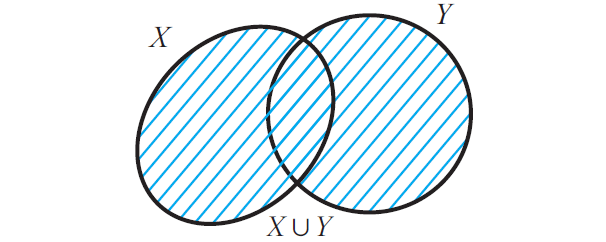UNION OF SETS
Subscribe to our ▶️ YouTube channel 🔴 for the latest videos, updates, and tips.
Union is one of the important operations on sets which can be used to combine two or more sets to form another set.
Let us discuss this operation in detail.
Let X and Y be two sets.
Now, we can define the following new set.
X u Y = {z | z ∈ X or z ∈ Y}
(That is, z may be in X or in Y or in both X and Y)
X u Y is read as "X union Y"
Now that X u Y contains all the elements of X and all the elements of Y and the figure given below illustrates this.

It is clear that X ⊆ X u Y and also Y ⊆ X u Y
Example 1 :
Let A = {1, 3, 5, 6}, B = {0, 5, 6, 7}, find A u B.
Solution :
A u B = {1, 3, 5, 6} u {0, 5, 6, 7}
A u B = {0, 1, 3, 5, 6, 7}
Example 2 :
Let A = {-1, 0, 2, 3, 4}, B = {0, 3, 4, 5} and C = {0, 4, 5, 7}. Find (A n B) u (B n C).
Solution :
A n B = {-1, 0, 2, 3, 4} n {0, 3, 4, 5}
A n B = {0, 3, 4}
B n C = {0, 3, 4, 5} n {0, 4, 5, 7}
B n C = {4, 5}
(A n B) u (B n C) = {0, 3, 4} u {4, 5}
= {0, 3, 4, 5}
Related Pages
3. Symmetric difference of two sets
Subscribe to our ▶️ YouTube channel 🔴 for the latest videos, updates, and tips.
Kindly mail your feedback to v4formath@gmail.com
We always appreciate your feedback.
©All rights reserved. onlinemath4all.com
Recent Articles
-
SAT Math Practice
Dec 05, 25 04:04 AM
SAT Math Practice - Different Topics - Concept - Formulas - Example problems with step by step explanation -
10 Hard SAT Math Questions (Part - 37)
Dec 03, 25 07:02 AM
10 Hard SAT Math Questions (Part - 37) -
Factorial Problems and Solutions
Dec 02, 25 09:27 AM
Factorial Problems and Solutions

